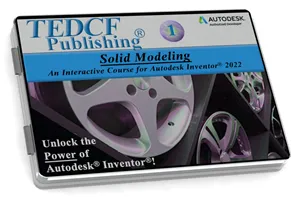Make bulletproof models and know what makes them structurally sound!
Sound practice is the theme of the Inventor 2022: Solid Modeling training course. While you learn the best way to build structurally sound models you'll also learn why one method is better than others. Know what professionals know.
You may use Autodesk Inventor 2022 professionally or just as a leisure pursuit. In either case you need to know that unstable models can change shape or fail to build. You can find it difficult or even impossible to edit poorly constructed models, and once you put them in your assemblies you have done nothing more than create misleading information and wasted your time. It's just a fundamental fact. Models need to be constructed using sound practices.
The Solid Modeling course for Inventor 2022 shows you best practices. You'll learn why one method creates high quality models while other methods don't. So you'll see what poor practice produces and understand why good procedures are used by professionals.
Most professional users learn from their mistakes. In fact it can take years to learn quality skills by a trial and error learning approach. They watch YouTube and get both good and bad advice. They take training classes that only teach a small portion of what you really need to know. Typically classes like these showcase the software instead of teaching you what you need to know. So the end result is years of using bad methods to produce nice looking but structurally unsound models.
So what is a structurally unsound model? The easiest way to explain this is to describe a sound model. Inventor models should be easy to edit. Features on models need to be adjusted from time to time. So you need to be able to change them without affecting other features without your knowledge. A structurally unsound model can change without your knowledge. So you can intentionally change a feature to make it longer, for example, and a different feature becomes shorter as a result. In other words, you have no control over your model.
The Solid Modeling course shows you how to take control of your models. It also shows you fast ways of creating them. So the goal of this course is to help you streamline your work and to help you product structurally sound models.
Seasoned Inventor users will also unlearn bad habits. If you've used Inventor for a while you'll learn methods that improve your speed and quality of work. Many of our customers report that they thought they knew how to use the software, but didn't know how wrong they were.
The Autodesk Inventor 2022: Solid Modeling course shows best practices and teaches you how to increase the speed and productivity of your work.
115 Lessons (Listed Below)
10.6 hours of instruction
You can also browse through the lessons from the following Inventor 2022 courses and watch sample lessons.
Inventor 2022: Solid Modeling Inventor 2022: Assemblies and Advanced Concepts Inventor 2022: 2D Drafting and Customization Inventor 2022: Sheet Metal Design Inventor 2022: Tube and Pipe Routed Systems Inventor 2022: Inventor Studio Made Simple Inventor 2022: iLogic Made Simple Inventor 2022: Fea Made Simple Inventor 2022: Dynamic Simulation Made SimpleOur Inventor courses require No Installation. You can watch them on any device connected to the internet.
You will receive an email containing your User Name and Password. Login to your account and start learning. It's that easy.
While you're logged into your account you can download files used in the courses, watch lessons, and practice the tasks taught in the lessons. Keep in mind that you will use your installation of Inventor to practice.
Get your Inventor 2022 training now. You can start learning in minutes.
Autodesk Inventor® 2022:
Solid Modeling
No Installation Required
Watch from any device connected to the internet.

$59.95 - $229.95
Watch Sample Lessons
Watch the first hour of the Solid Modeling course for Autodesk Inventor 2022.
 Click to Watch!
Click to Watch!Solid Modeling
10.6 hours of instruction
Lessons
Introduction
Getting Started
The Open Dialog Box
Create a Project
Overview of the User Interface
The Heads Up Display
Create a Sketch
Sketch Constraints
Extruding a Profile
The In-Canvas Display
In-Canvas Display Settings
The Marking Menu
Marking Menu Customization
Editing Profiles
View Cube and Navigation Bar
Sketches vs Profiles
Solid Bodies
Constraining Profiles
Creating Profiles From Solids
More Mini-Toolbars
Default Work Planes
Revolve a Feature
Trick for Constraining Sketches
Constraining the Axis of Revolution
Projecting Geometry
Creating Work Planes
Extruding to a Plane
Sharing Sketches
Construction Lines
Centerlines
Mirroring Features
Circular Feature Array
Rectangular Feature Array
Application Options
Creating Holes
Custom Hole Presets
Placing Holes Part I
Placing Holes Part II
Creating Hole Patterns Part I
Creating Hole Patterns Part II
Threaded Holes
Advanced Thread Settings
Finishing Features
Clearance Holes
Pipe Thread Holes
Fundamentals of the Shell Command
Using the Shell Command
3D Construction Stage I
3D Construction Stage II
3D Construction Stage III
Breaking Rules
Ribs Parallel to Sketch
Ribs Perpendicular to Sketch
Draft and Ejector Pads
Control Vertex Splines
Bridge Curve Splines
Interpolation Splines
Constraining Splines
Tweaking Splines
Bowties
Fit and Tension
Sweep
Sweep Path and Guide Rail
Sweep Path and Guide Surface
Introduction to 3D Sketches
Using 3D Sketches
3D Splines and Coils
Mirroring Sketch Geometry
Editing Mirrored Sketches
Automating Patterns
Linear Slots
Arced Slots
Lofts
Loft Conditions
Loft Transition and Point Mapping
Lofts with Rails
Rails on Cylindrical Lofts
Tricks for Round Spline Sweeps
Square Sweeps
Centerline Lofts
Skin Bodies
Adjusting Color
Closed Loop Lofts
Area Lofts
Loft Strategies
The Lip Command
Coils and Springs
Parameters and Tolerances
Linking Excel Spreadsheets
Threads
Importing Points
The Bend Part Command
Bending Conical and Loft Parts
Direct Edit Move
Direct Edit Size
Direct Edit Rotate
Direct Edit Delete
The Emboss Command
The Boss Command Part I
The Boss Command Part II
Ribs on Bosses
The Rest Command
The Grill Command
Rule Fillets
Replacing and Splitting Faces
The Sculpt Command
Freeform TSpline Basics
Freeform Symmetry
Detailing Freeform Features
Modifying and Stitching Surfaces
Patch Stitch IGES Files I
Patch Stitch IGES Files II
2D Equation Curves
3D Equation Curves
Conclusion
